©
2004 Jeff Matthews & napoli.com
Beverello,
molo (port of Naples)
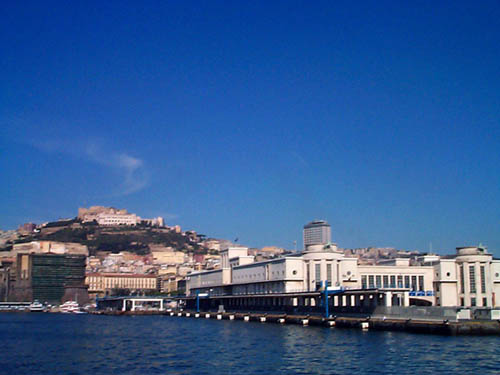 Directly across
from Maschio Angioino --the gloomy fortress at the port--
is the pier for ferries and hydrofoils. It is named Molo [pier]
Beverello and includes the facility adjacent to it on the east,
the large passenger terminal built in the 1930s (photo). Molo Beverello
handles all of the day traffic to the Sorrentine peninsula, to the islands
of Ischia and Capri, and even car and passenger traffic to Sicily and
Sardinia. It also handles larger vessels on Mediterranean cruises. Directly across
from Maschio Angioino --the gloomy fortress at the port--
is the pier for ferries and hydrofoils. It is named Molo [pier]
Beverello and includes the facility adjacent to it on the east,
the large passenger terminal built in the 1930s (photo). Molo Beverello
handles all of the day traffic to the Sorrentine peninsula, to the islands
of Ischia and Capri, and even car and passenger traffic to Sicily and
Sardinia. It also handles larger vessels on Mediterranean cruises.
Adjacent
to Molo Beverello on the west is another pier, Molo S. Vincenzo.
It is little used, simply because it is too small. The city has announced
that it going to dump 94 million euros into that part of the port --
(who knows, perhaps even directly into the water, if some critics of
the plan are to be believed).
Molo S.
Vincenzo -- for some reason-- I think is what has stopped me from ever
getting out onto the main breakwater of the port of Naples. It is very
long and terminates in a lighthouse and a charming statue of San Gennaro,
the patron saint of Naples. Every time I try to gain access to whatever
secret little passageway will get me out on that breakwater, I run afoul
of some "no entry" sign around Molo S. Vincenzo. Yet, whenever I sail
out through the harbor on the way "to smite the sounding furrows and
sail beyond the baths of all the western star", I see people sitting
out there, fishing! They didn't row out there, either, because I can
see their cars parked nearby. They drove out there on the street (of
sorts) that runs the entire length of the breakwater on the sheltered
side.
Whatever
the case, for 94 million euros I want my own entrance. (No doubt, it
will be like the one I refer to in the entry for November 11 (above).
Anyway,
the found an unexploded WW2 bomb at the bottom of the harbor near the
passenger terminal the other day while they were dredging. About five
feet long and two in diameter, the bomb was a reminder of the days when
the entire port section of the city and other strategic sites such as
the train station were the target of Allied air-raids against the Germans,
who were occupying Naples.
The newspaper
article waxed nostalgic about the possibility of still finding
some legible graffiti on the bomb casing, such as "Hey, Benito --This
one's for you!" Alas, there was no such historic drivel; the bomb was
removed by divers of the SDAI (Servizi difesa antimezzi insidiosi)
-- the bomb squad-- and everything returned to normal.
There is
legitimate concern, however, about the next time. There is almost certain
to be a next time, too, since dredging in the harbor will continue for
the planned renovation of a large section of the passenger piers. Also,
construction of new buildings along the entire port-side road, via Marina,
often entails digging way down into terrain perhaps undisturbed since
1943. The entire area was a target, and the chances of coming across
even more unexploded ordinance are high.
The
port of Naples extends to the east for another mile or so. Once past
the main passenger terminal adjacent to Molo Beverello, the facilities
are almost totally given over to container ships and other freighters.
Like any other area that has undergone a century of rebuilding, decay,
bombardment, more decay and more rebuilding, the entire area along the
main road that runs the length of the port is an unbelievable hodgepodge
of architecture.
The
great boom of construction—called the risanamento—at
the turn of the twentieth century tore down the ancient port facilities
in order to build the main road that leads east out of the city. That
construction eliminated all but the most obvious signs that there was
ever an olden Naples in that area; for example, city builders of 1900
left standing a few remnants of the old Carmine Castle across from Piaza
Mercato.
Later
construction during the 1930s is responsible for a number of large buildings
in the port, including the main passenger terminal. The port—especially
the eastern end—was then heavily bombed in WW II. Newer office
buildings put up over the last 20 years along the long portside road
have now repaired much of that damage—if adding to the eye-jolt
of large glass and steel buildings right next to what is left of the
Church of Santa Maria di Portosalvo, built in 1554. The tiny church
was once the spiritual home to many Neapolitan sailors. Outside the
church is a stone cross, a monument to the retaking of the Kingdom of
Naples by the Bourbons in 1799, which episode ended the short-lived
Neapolitan Republic.
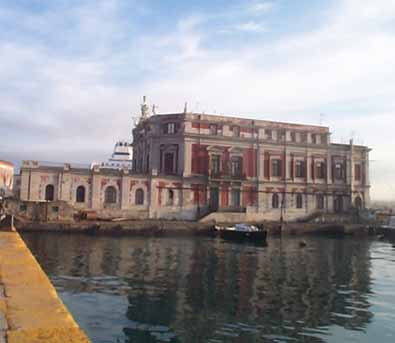 Near the church, but across
the main road and within the port itself, at water's edge, is the only
other obvious bit of earlier Naples. It is the old quarantine station
(photo), the Immacolatella, finished in the 1740s. It was built
to the plans of D.A. Vaccaro, the proment painter, scultpor, and architect
whose works are scattered throughout Naples, including the beautiful
majolica-tile courtyard of the Church of Santa Chiara. The Immacolatella
is so-called from the sculpture of the Immaculate Virgin above the facade. Near the church, but across
the main road and within the port itself, at water's edge, is the only
other obvious bit of earlier Naples. It is the old quarantine station
(photo), the Immacolatella, finished in the 1740s. It was built
to the plans of D.A. Vaccaro, the proment painter, scultpor, and architect
whose works are scattered throughout Naples, including the beautiful
majolica-tile courtyard of the Church of Santa Chiara. The Immacolatella
is so-called from the sculpture of the Immaculate Virgin above the facade.
Extensive expansion and modernization of the entire port of Naples will
continue throughout 2004.
University
(2)
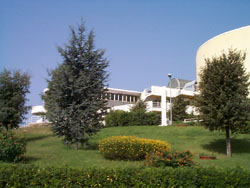 I
went out to the new University campus at Monte Sant'Angelo the other
day. It is exactly that: a campus on the US model, a city unto itself
in an area way out in what used to be acres of greenery
on the periphery of Naples in Fuorigrotta in back of the S. Paolo soccer
stadium. I
went out to the new University campus at Monte Sant'Angelo the other
day. It is exactly that: a campus on the US model, a city unto itself
in an area way out in what used to be acres of greenery
on the periphery of Naples in Fuorigrotta in back of the S. Paolo soccer
stadium.
It looks
to be about half-finished and has a futuristic look about it -- lots
of glass and steel, with tubular passages from building to building.
Thus far, the campus houses the departments of physics, chemistry,
biology and computer science -- you know, all the "hard stuff". The
humanities are still back in the middle of
town in converted 14th-century monasteries, no doubt a more
appropriate setting for studying the metaphors of Dante and Boccaccio.
Eventually, however, even students of languages and literature will
move out to the new site. A subway station directly beneath the campus
will link to the main line into the center of town. It's an ambitious
project.
Black market
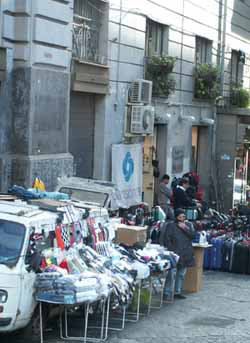 There
is a bit of unpleasantry going on down at via San Gregorio Armeno, the street in the historic
center of Naples known for the shops that make and sell the wherewithal
for your yearly Christmas presepe, the manger display. There
is a bit of unpleasantry going on down at via San Gregorio Armeno, the street in the historic
center of Naples known for the shops that make and sell the wherewithal
for your yearly Christmas presepe, the manger display.
Legitimate
shops line both sides of the narrow street for the entire block between
via S. Biagio dei Librai and via Tribunali. They are licensed to be
open and do business. They are getting extreme competition from the
many "abusivi" ("those who abuse the law") in the area, itinerant
street vendors selling their own Christmas decorations.
It is no
secret that Naples is a hotbed of blackmarketeering and just plain street-hustling,
people out trying to make a buck. In some cases, these unlicensed vendors
are not so itinerant -- no opening of the jacket to reveal rows of tiny
angels and stars pinned to the lining -- ("Pssst. Hey, buddy -- wanna
buy some tinsel?") They use quickly deployable tables and shelves to
display boxloads of goods right on the open street just feet from legitimate
shops trying to do business. The shopkeepers have complained, and the
police have been moving in to chase off the "abusivi," who have,
in turn, reacted violently by overturning rubbish bins and setting fire
to the contents. Who knows if the situation will settle down in the
coming weeks?
furbone,
motorcycles (2)
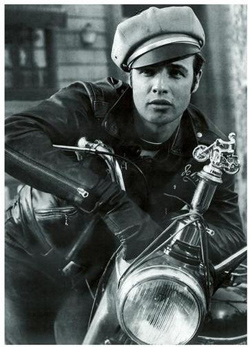 All
I really remember about the great 1953 film, The Wild One, starring
Marlon Brando (photo), was that it was very loud with the sound of motorcycles.
That may have had a certain quaint charm in the early 50s, but not in
2002 and not in Naples. All
I really remember about the great 1953 film, The Wild One, starring
Marlon Brando (photo), was that it was very loud with the sound of motorcycles.
That may have had a certain quaint charm in the early 50s, but not in
2002 and not in Naples.
The other
night, I was third or fourth in line in my car, waiting to turn left
at the light change when a homegrown version of the Black Rebels Motorcycle
Club went screaming by -- about 15 punks on bikes, not one helmet among
them, weaving in and out of traffic and making obscene gestures at all
of us poor saps in cars as they sped right through the intersection
and red-light. No doubt they were on their nefarious way to harass some
cleancut cafe waitress on her way home to Pop. They
all made it through totally unscathed. These are the "furboni" (Big
Clever Ones), those who always get away with everything, and I
thought, "C'mon -- just once. Maybe not under a train, but... some
justice, some moral equivalent of a train." I have only
seen that "just once"—well, just once, in Naples.
I'm stopped
in my little minimobile at a railway crossing. The red warning lights
are flashing and the barrier has just come down in front of me; I am
first in line on my side of the tracks. I resign myself to wasting another
two or three minutes of the paltry few thousand remaining to me. I examine
the barrier on my side. It is a good barrier—imposing, straight
and true, a you-shall-not-pass kind of barrier, if ever there was one.
Casually I glance over at the other side and notice the other barrier.
It is not straight. It has a big peaked bump in the middle—it
looks like the universal symbol at camp grounds which means "You May
Put Your Tent Here." At some time that thing played Guillotine opposite
some poor car's Marie Antionette. This, in itself, makes me smile. This
is not the sense of justice I mentioned a second ago; this is justice's
evil step-sibling, which the Germans so delightfully call Schadenfreude
-- joy at the misfortune of others
Two young
thugs on a motorcycle now roll up to that barrier, having adroitly and
with utter disdain for the laws of Nature, Nature's God, and the Italian
traffic code, zigged and zagged their way around a dozen other vehicles
to get to the front. (It wouldn't be so bad, except that they both have
that perpetual "Don't you wish you were as cool as we are?" smirk frozen
on their totally moronic ratty little punk faces.) They don't ask --
rather, they tell-- the keeper of the barrier that they are going through
anyway, and he glumly glances down the tracks, hoping that the train
isn't close enough to ruin his fatality-free safety record (at least
for the current week). Now, on their side of the tracks they pass rather
nicely under that hump. The driver lowers his head, which isn't too
big, anyway, and he doesn't really have to tilt the bike too much. Moron
number two just slumps down and hangs on.
On my side,
however, things aren't so easy. "My" barrier has no hump and is not
about to let a couple of human snakes like this slither under, no questions
asked. This becomes clear to the "furbone" driver, who now has
to slide out of the saddle to support himself, his machine and passenger
with one leg while he tilts his bike low enough to shimmy under. He
is having difficulty and has put together a combination of stutter-stepping,
shuffling and kick-boxing -- like an alien auditioning for Saturday
Night Fever. He is not amused and is visibly irritated at
the fact that his audience --me included --is watching him lose his
cool. In fact, his cool is about to turn to small puddles, since there
is a train approaching.
In the
meantime, "furbone" number two, the passenger, in an attempt to help,
actually stands up from the passenger seat as the bike lists low to
the ground. Both his feet are on the ground (where his knuckles usually
drag), and this, of course, takes some weight off the bike, enabling
the driver to wriggle under. He does so. Then he straightens up in the
saddle, gives a satisfied ego-vrooom! on the controls and roars
off. Not until he turns his head— twenty yards down the road—to
have a nice collective laugh with his friend at the expense of all of
us still waiting for the train to pass, does he realize that his co-moron
is still standing inside the barrier, knees still bent, arms outstretched,
looking like a water-skier waiting to get up.
The skier
scurries under the barrier to get out of the way of the train. His ride
turns around and comes back to get him, and they both have to put up
with a chorus of hooting, honking and laughing -- derision much more
painful to them, I can well imagine, than being flattened by a million
tons of metal. They had been caught being uncool. The train didn't get
them. It wasn't real justice -- but it was close enough.
Magna Grecia
| The
map shows the extensive network of Greek cities in southern
Italy during the age of Magna Grecia. The first settlement was
on the island of Ischia. That settlement then moved across to
the mainland and founded Cuma. (More in the map
section.) |
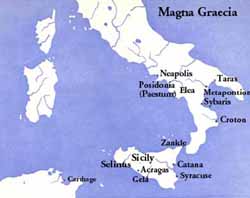 Shortly
after the year 800 b.c.—and lasting for about three-hundred
years—the peoples of the Aegean peninsula and archipelago, collectively
"Hellenes"—"Greeks"—but individually Chalcidians, Euboeans,
Messenians, Achaeans, Spartans, Ionians and Peloponnesians, spread
to the west and colonized portions of Sicily and the southern Italian
peninsula. Those settlements made up what was known as Magna Grecia
—Greater Greece— and within its borders there arose great
centers of Hellenic culture. In what would one day be "Italy," towns
such as Cuma, Naples, Paestum, Siracuse, Taranto, Metaponte and Croton
became marketplaces for the science and philosophy of Archimedes,
Pythagoras and Plato, ideas which survived the demise of Magna
Grecia, itself, and so influenced its Latin conquerors that today
most Europeans and descendants of Europeans regard themselves as inheritors
of a wondrous hybrid culture called "Greco-Roman". Shortly
after the year 800 b.c.—and lasting for about three-hundred
years—the peoples of the Aegean peninsula and archipelago, collectively
"Hellenes"—"Greeks"—but individually Chalcidians, Euboeans,
Messenians, Achaeans, Spartans, Ionians and Peloponnesians, spread
to the west and colonized portions of Sicily and the southern Italian
peninsula. Those settlements made up what was known as Magna Grecia
—Greater Greece— and within its borders there arose great
centers of Hellenic culture. In what would one day be "Italy," towns
such as Cuma, Naples, Paestum, Siracuse, Taranto, Metaponte and Croton
became marketplaces for the science and philosophy of Archimedes,
Pythagoras and Plato, ideas which survived the demise of Magna
Grecia, itself, and so influenced its Latin conquerors that today
most Europeans and descendants of Europeans regard themselves as inheritors
of a wondrous hybrid culture called "Greco-Roman". Driven
by the need for trade and the desire to set up relations with the Etruscans
of the central and northern Italian peninsula, Euboeans founded the
first colony of Magna Grecia, Pithecussae, on what is now called the
island of "Ischia" in c. 750 b.c. Shortly thereafter, they moved to
the mainland and founded Cuma. They were
followed by the Chalcidians at Zancle (modern "Messina") on Sicily;
then, also on Sicily, the Corinthians founded Siracuse, which would
develop into one of the great cities in the ancient Greek world. Back
on the mainland, along the bottom of the boot, the Aecheans founded
Metapotum and Croton, and the Spartans settled at Tarantum. Within a
century of the first colony at Ischia, the Greeks had established themselves
as a powerful trading bloc in southern Italy and were already being
jealously watched by the Carthaginians and Phoenicians. Naples, itself—somewhat
late in the scheme of Magna Grecia— was founded as "Parthenope"
in the 6th century b.c. It was a second-generation colony, in that it
was settled by the Euboeans of Cuma just to the north, people who by
now no doubt thought of themselves simply as "Cuman"'. They rebuilt
somewhat inland a few years later and called it New City, Neapolis—Naples.
The last important Greek colony to be founded in Italy was Acgragas
(modern Agrigento) in 580 b.c.
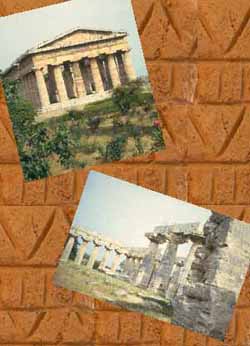 Many
of the cities of Magna Grecia that have since drifted into obscurity
are as old as Athens, itself, and—if history had been different—might
have spawned Golden Ages of their own that we would be reading about
in history books today. That was not to be, however, for a number of
reasons. One of them was that although the atmosphere in Magna Grecia
is said to have been somewhat freer than in Greece, politically it suffered
from the same fragmentation as the homeland. The settlements of Greater
Greece were independent and autonomous, and, like the city-states of
Greece, they spent much of their time fighting each other. Between warring
among themselves and fighting to subdue the native populations of Sicily
and the southern Italian mainland, it is no wonder that Magna Grecia
never managed to present a united front against those who, in historical
hindsight, were or would become their true enemies—Carthage and,
of course, Rome. Many
of the cities of Magna Grecia that have since drifted into obscurity
are as old as Athens, itself, and—if history had been different—might
have spawned Golden Ages of their own that we would be reading about
in history books today. That was not to be, however, for a number of
reasons. One of them was that although the atmosphere in Magna Grecia
is said to have been somewhat freer than in Greece, politically it suffered
from the same fragmentation as the homeland. The settlements of Greater
Greece were independent and autonomous, and, like the city-states of
Greece, they spent much of their time fighting each other. Between warring
among themselves and fighting to subdue the native populations of Sicily
and the southern Italian mainland, it is no wonder that Magna Grecia
never managed to present a united front against those who, in historical
hindsight, were or would become their true enemies—Carthage and,
of course, Rome.
In the
4th century b.c., with Alexander the Great looking to the east to conquer
the civilized world of his day, the Persian Empire, the settlements
of Magna Grecia were, more or less, on their own. Sicily had become
the most powerful city-state of Magna Grecia by that time, and its ruler,
Dionysius, tried to establish a single Empire of Magna Grecia starting
in 400 b.c. It was, in a way, quite like Phillip of Macedonia's (Alexander's
father) plan to unify Greece, itself. A united southern Italy might
have been a forerunner of, or maybe —if we play the 'what-if'
game of history— a substitute for the Roman Empire, itself. Alas
for Dionysius and his less capable successors, they couldn't fend off
the Carthaginians or the increasingly belligerent native tribes of Italy.
When one of these tribes, the Romans, took Taranto in 272, b.c. Greek
history in Italy was overwhelmed by the onrush of Roman history. Magna
Grecia was at an end.
In Naples
you are in Magna Grecia. The Archaeological Museum is, appropriately, at what
was once the northwest corner of the original wall of the city, 2,500
years ago. A few blocks away you can still find part of that wall, and
you can walk the grid of the original streets. They're covered with centuries
of other stone and decades of asphalt, but they're down there. Also,
on the isle of Megaride, the site of the so-called Castel
dell'Ovo, you are on the site of the original city of Parthenope.
A little further afield, the ruins of Cuma
and Paestum can give you insight into what happens to
cities when people don't live in them for a few thousand years. And,
as a final note to what is left of Greater Greece in our immediate area,
there are the ruins, discovered in this century a bit south of Paestum,
of the city of Elia (modern Velia). It was the home of Parmenides and
Zeno and was founded in the 5th century b.c. by refugees from the Persian
invasions of eastern Greece of that epoch. Take the autostrada for Reggio
Calabria, exit at Battipaglia and head towards Omegliano Scalo. Ask
for the "scavi di Velia". In nearby Ascea, there is even a hotel
called Magna Grecia! Is nothing sacred?
Greeks
in Naples
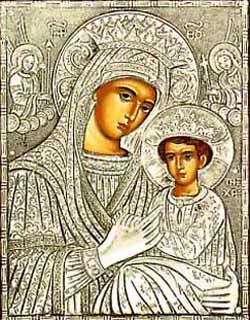 Considering
the Greek history of Naples, it isn't surprising that one should find
considerable amounts of Greek masonry beneath the city and in the outlying
areas. It is, however, the little bits and pieces of "mental masonry"
--less tangible fragments of Greekness in the history and customs of
Naples-- that fascinate the most. One such item, for example, is the
simple fact that after the fall of the Roman Empire, under Justinian's
brief unification of the eastern and western empires, Greek was again
the language of Naples. A thousand years after it first reached these
shores, Greek was for a brief time once again the language of official
commerce, politics and religion. Considering
the Greek history of Naples, it isn't surprising that one should find
considerable amounts of Greek masonry beneath the city and in the outlying
areas. It is, however, the little bits and pieces of "mental masonry"
--less tangible fragments of Greekness in the history and customs of
Naples-- that fascinate the most. One such item, for example, is the
simple fact that after the fall of the Roman Empire, under Justinian's
brief unification of the eastern and western empires, Greek was again
the language of Naples. A thousand years after it first reached these
shores, Greek was for a brief time once again the language of official
commerce, politics and religion.
That last
item, religion, has perhaps to do with another piece of Greekness still
left in the city. The long history of the Greek Orthodox Church in Naples and southern Italy,
in general, has begotten the curious tradition of otherwise typical
Roman Catholics calling upon the services of a Greek Orthodox priest
to perform ritual blessings of newly built houses and even to ward off
the "evil eye".
I know,
personally, of two such cases. A friend of mine moved into a new house
and simply called up the priest from the one Greek Orthodox church in
Naples to come over and bless the place. Also, a woman I know was a
librarian at one of the many university libraries in town. Books were
disappearing. Whether that was due to simple mundane larceny or otherworldly
book-fairies was irrelevant. She called the same church and got a young
priest to come over and bless the library. Interestingly, he was aware
of the custom, yet guarded in his willingness to muscle in on Roman
Catholic turf. Nevertheless, he did as requested.
My friend's
house is doing fine, but I never found out if the books were returned
or, at least, stopped disappearing. That, of course, is not the point.
In both cases, my friends simply shrugged off my "But-you're-a-Catholic"
challenge. Everyone knows the Greeks have "something special".
soccer
(1)
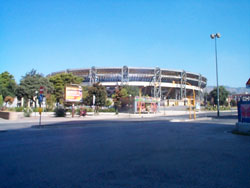 Italian
professional soccer is built along the principles of one major league,
the A league; then, a minor league, the B league; then, the very minor
leagues, the C1 and C2 league. Each league has 18 teams; at the end
of each season, the last 4 teams in the A league are "sent down" to
the B league, and the top four in the B league move up. Similarly, the
bottom four in the B league exchange places with the top four in the
C1 league, and so forth with C2. In theory, then, even a small-town
team can win its up from the bottom of the minors through the B league
and into the A league, where it, too, has a shot at the national title.
That seldom happens, but the hope of being just such a "Cinderella"
team keeps soccer in small towns going. Conversely, a big-city, once
high-and-mighty team such as Naples can lose its way down and out of
the A league and into the B league. That happened in the late
1990s to Naples. They struggled back up to the A league for a season
and then went down again to the B league. Italian
professional soccer is built along the principles of one major league,
the A league; then, a minor league, the B league; then, the very minor
leagues, the C1 and C2 league. Each league has 18 teams; at the end
of each season, the last 4 teams in the A league are "sent down" to
the B league, and the top four in the B league move up. Similarly, the
bottom four in the B league exchange places with the top four in the
C1 league, and so forth with C2. In theory, then, even a small-town
team can win its up from the bottom of the minors through the B league
and into the A league, where it, too, has a shot at the national title.
That seldom happens, but the hope of being just such a "Cinderella"
team keeps soccer in small towns going. Conversely, a big-city, once
high-and-mighty team such as Naples can lose its way down and out of
the A league and into the B league. That happened in the late
1990s to Naples. They struggled back up to the A league for a season
and then went down again to the B league.
The salad
days of Neapolitan soccer were in the 1980s and early 90s, a period
in which Argentine superstar, Diego Maradona, led Naples to two national
championships. In those days, streets on a Sunday afternoon after a
homegame were either full of flag-waving, horn-tooting celebrations
of victory or glum fans wandering slowly home, wondering just what had
gone wrong. Fan involvement was intense.
Things
have gone very wrong in the last few years, and any sort of soccer emotion
at all is noticeably absent. There are few victories to speak of, and
no one seems to care about the defeats. Only a few thousand diehard
fans even bothered to show up at the giant San Paolo stadium yesterday
to watch Naples play Lecce. It was just as well --it was 1-1 tie. That
draw added one measly point to Naples' total in the league standings
(a victory counts 3 points) and left them still mired fourth from the
bottom in what is called the "demotion zone". BUT -- it is the demotion
zone of the B league! Naples is at the gates of true soccer obscurity
-- the C league, as minor as you can get in Italian professional soccer.
If Naples
goes down to the C league, it will be the first time that has happened
since the league system was set up in its current form back in the 1920s.
This morning at the local coffee-bar, cynics were joking about being
in the C league next season, where they might be able to win a game
or two—maybe against that powerhouse team from the island of Ischia.
They can play on the beach where the few remaining fans will be able
to watch in comfort from the roadside.
They certainly
won't need the San Paolo stadium in Fuorigrotta (photo, above).
De
Simone, Roberto
 Neapolitan
musicologist Roberto De Simone is a most remarkable person. He was the
artistic director of the San Carlo Theater in the late 1980s and was
appointed director of the Naples Conservatory in 1995. He has spent
his professional life rejuvenating the cultural history of his city.
This includes collecting folk tales and music, and reviving a number
of seldom- or never-performed pieces from the vast repertoire of 18th-century
Neapolitan comic opera— works by Pergolesi
and Jomelli, among others. Neapolitan
musicologist Roberto De Simone is a most remarkable person. He was the
artistic director of the San Carlo Theater in the late 1980s and was
appointed director of the Naples Conservatory in 1995. He has spent
his professional life rejuvenating the cultural history of his city.
This includes collecting folk tales and music, and reviving a number
of seldom- or never-performed pieces from the vast repertoire of 18th-century
Neapolitan comic opera— works by Pergolesi
and Jomelli, among others.
He has
written, among much other work, a requiem in memory of the poet Pier
Paolo Pasolini, a cantata for the 17th-century Neapolitan revolutionary,
Masaniello, and, in 1999, a remarkable
oratorio, "Eleonora," in honor of the
republican heroine of the Neapolitan revolution of 1799. He is currently
reworking his stage version of The Cat Cinderella, based on the
oldest version of that fairy-tale, a dialect tale by Giambattista Basile from the early 1600s. As with
many of his other works, he will take the show on the road in a version
that employs a modified Neapolitan dialect in order to make the work
accessible to a wider audience.
Copyright
(2)
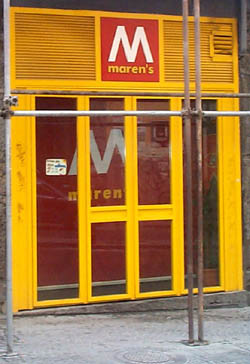 Massimiliano
Amatrice is risking a lawsuit, but the publicity is probably worth it.
He has opened a hole-in-wall, stand-up or take-out fast-food place near
Piazza del Gesù in the heart of downtown Naples. His advertising
logo, displayed prominently over the entrance, is a large red letter
M, clearly meant to remind you of McDonald's. Below the M is the word
Maren's -- an English-looking play on the Neapolitan word for
snack, "marenna", itself a variation of the Italian "merenda". The M
also stands for "mamma"—mother—says the proprietor, a reminder
that he prepares snacks just like mother used to make. Indeed, there
are no fast-food burgers here --just typical and tradtional Neapolitan
fare: small pizzas, enormous sandwiches with ham and mozzarella, rice
balls, etc. Massimiliano
Amatrice is risking a lawsuit, but the publicity is probably worth it.
He has opened a hole-in-wall, stand-up or take-out fast-food place near
Piazza del Gesù in the heart of downtown Naples. His advertising
logo, displayed prominently over the entrance, is a large red letter
M, clearly meant to remind you of McDonald's. Below the M is the word
Maren's -- an English-looking play on the Neapolitan word for
snack, "marenna", itself a variation of the Italian "merenda". The M
also stands for "mamma"—mother—says the proprietor, a reminder
that he prepares snacks just like mother used to make. Indeed, there
are no fast-food burgers here --just typical and tradtional Neapolitan
fare: small pizzas, enormous sandwiches with ham and mozzarella, rice
balls, etc.
The large
letter actually reminds you more of the Metropolitana logo common throughout
Europe and unless McDonald's wants to make a case that they own part
of the alphabet and wants to sue most of the subway lines on the continent,
this may wind up in the same category as the time Warner Bros. threatened
Groucho Marx with a lawsuit over the title of a Marx Brothers film,
A Night in Casablanca, so close on the heels of the Warner Bros.
film, Casablanca. Groucho reminded the studio that he and
his brothers had been brothers for longer than the Warner Bros.
had been brothers, and that he was seriously considering a countersuit
over that. The studio let it drop. Come to think of it, there was a
great 1931 German movie called "M" starring Peter Lorre as a psychopathic
child-molester/murderer. It was directed by Fritz Lang. Can he sue somebody?
|
